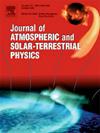Time series analysis of the impact of global warming on Türkiye
IF 1.9
4区 地球科学
Q3 GEOCHEMISTRY & GEOPHYSICS
Journal of Atmospheric and Solar-Terrestrial Physics
Pub Date : 2025-09-22
DOI:10.1016/j.jastp.2025.106647
引用次数: 0
Abstract
According to the assessments of the Intergovernmental Panel on Climate Change (IPCC), Türkiye, located within the Mediterranean basin, is among the regions most susceptible to the adverse impacts of climate change. This heightened vulnerability is largely attributed to its geographic location, climatic characteristics, and socio-economic structure, which together amplify the risks associated with rising temperatures and increasing climate variability. In the present study, monthly mean air temperature data for Türkiye, recorded by the Turkish State Meteorological Service between 1970 and 2022 (TSMS dataset), were analyzed in combination with reanalysis-based satellite observations obtained from the ERA5 (ERA5 dataset). These historical records formed the foundation for developing temperature projections extending to the year 2050. To achieve this, two complementary time-series forecasting approaches were applied: the Long Short-Term Memory (LSTM) deep-learning model, known for its ability to capture nonlinear dependencies and long-range temporal patterns, and the Seasonal Auto-Regressive Integrated Moving Average (SARIMA) model, a classical statistical method suitable for handling seasonality and trend components in climate data. The projection results revealed that Türkiye's mean temperature anomaly relative to the 1970–1980 baseline period is expected to rise by approximately 2.52 °C when based on in-situ observational data, and by about 3.48 °C when derived from ERA5 reanalysis estimates. These findings consistently indicate a significant warming trajectory, regardless of the dataset or modeling approach applied.
全球变暖对土壤影响的时间序列分析
根据政府间气候变化专门委员会(IPCC)的评估,位于地中海盆地内的t rkiye是最容易受到气候变化不利影响的地区之一。这种脆弱性的增加主要归因于其地理位置、气候特征和社会经济结构,这些因素共同放大了与气温上升和气候变率增加相关的风险。在本研究中,结合ERA5 (ERA5数据集)获得的基于再分析的卫星观测数据,分析了土耳其国家气象局1970 - 2022年记录的 rkiye月平均气温数据(TSMS数据集)。这些历史记录为发展到2050年的温度预测奠定了基础。为了实现这一目标,采用了两种互补的时间序列预测方法:长短期记忆(LSTM)深度学习模型,以其捕获非线性依赖关系和长期时间模式的能力而闻名,以及季节自回归综合移动平均(SARIMA)模型,这是一种经典的统计方法,适用于处理气候数据中的季节性和趋势成分。预估结果显示,与1970-1980年基线期相比,基于原位观测资料的 rkiye平均温度距平预计将上升约2.52℃,而基于ERA5再分析估计的距平预计将上升约3.48℃。无论采用何种数据集或建模方法,这些发现一致表明一个显著的变暖轨迹。
本文章由计算机程序翻译,如有差异,请以英文原文为准。
求助全文
约1分钟内获得全文
求助全文
来源期刊

Journal of Atmospheric and Solar-Terrestrial Physics
地学-地球化学与地球物理
CiteScore
4.10
自引率
5.30%
发文量
95
审稿时长
6 months
期刊介绍:
The Journal of Atmospheric and Solar-Terrestrial Physics (JASTP) is an international journal concerned with the inter-disciplinary science of the Earth''s atmospheric and space environment, especially the highly varied and highly variable physical phenomena that occur in this natural laboratory and the processes that couple them.
The journal covers the physical processes operating in the troposphere, stratosphere, mesosphere, thermosphere, ionosphere, magnetosphere, the Sun, interplanetary medium, and heliosphere. Phenomena occurring in other "spheres", solar influences on climate, and supporting laboratory measurements are also considered. The journal deals especially with the coupling between the different regions.
Solar flares, coronal mass ejections, and other energetic events on the Sun create interesting and important perturbations in the near-Earth space environment. The physics of such "space weather" is central to the Journal of Atmospheric and Solar-Terrestrial Physics and the journal welcomes papers that lead in the direction of a predictive understanding of the coupled system. Regarding the upper atmosphere, the subjects of aeronomy, geomagnetism and geoelectricity, auroral phenomena, radio wave propagation, and plasma instabilities, are examples within the broad field of solar-terrestrial physics which emphasise the energy exchange between the solar wind, the magnetospheric and ionospheric plasmas, and the neutral gas. In the lower atmosphere, topics covered range from mesoscale to global scale dynamics, to atmospheric electricity, lightning and its effects, and to anthropogenic changes.
 求助内容:
求助内容: 应助结果提醒方式:
应助结果提醒方式:


